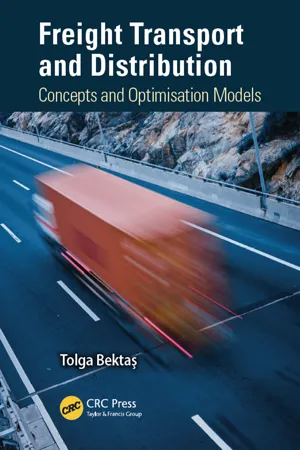
- 267 pages
- English
- ePUB (mobile friendly)
- Available on iOS & Android
About This Book
This book serves as a primer on freight transportation and logistics, providing a general and broad coverage of concepts, mathematical models and methodologies available for freight transportation planning at strategic, tactical and operational levels. It is aimed at graduate students, and is also a reference book for practitioners in the field.The book includes preliminaries, such as mathematical modeling and optimisation algorithms. The book also features case studies and practical real-life examples to illustrate applications of the concepts and models covered, and to encourage a hands-on and a practical approach. The author has taught and published extensively in the field and draw on state-of-the-art scientific research. He has also been part of a number of practical research projects, which underpin the real life examples in the book.
Frequently asked questions
Information
Table of contents
- Cover
- Half Title
- Title Page
- Copyright Page
- Dedication
- Table of Contents
- Foreword
- Preface
- 1 Freight logistics, distribution and transport: Concepts
- 1.1 Actors
- 1.1.1 Shippers
- 1.1.2 Carriers
- 1.1.3 Intermediaries
- 1.2 Modes of transportation
- 1.2.1 Road
- 1.2.2 Rail
- 1.2.3 Air
- 1.2.4 Sea
- 1.2.5 Intermodal transportation
- 1.2.6 Intermodal terminals
- 1.2.6.1 Containerised transport
- 1.3 Choice of carrier and transportation mode
- 1.4 Shipment options
- 1.4.1 Direct and customised shipments
- 1.4.2 Consolidated shipments
- 1.5 Distribution structures
- 1.5.1 Single-echelon
- 1.5.2 Multi-echelon
- References and further reading
- 2 Locationinnetworks
- 2.1 Hub location problems
- 2.2 Common notation
- 2.3 p-Hub median problems
- 2.3.1 Single-allocation p-hub median problem
- 2.3.1.1 Quadratic integer programming formulation
- 2.3.1.2 Integer linear programming formulations
- 2.3.2 Multiple-allocation p-hub median problem
- 2.4 Capacitated hub location problems
- 2.5 Other types of hub location problems
- 2.5.1 p-Hub centre problem
- 2.5.2 Hub covering problem
- 2.6 Congestion in hub location problems
- 2.7 Facility location problems
- 2.7.1 Uncapacitated facility location problem
- 2.7.2 Capacitated facility location problem
- 2.8 Uncertainty in location problems
- 2.8.1 Scenario-based modelling
- 2.8.2 Recourse actions
- 2.9 Practical application: Hub location for time-sensitive cargo deliveries
- References and further reading
- 3 Transportation and service networks
- 3.1 Features of transportation networks
- 3.2 Common notation
- 3.3 Multi-commodity network flow and design
- 3.3.1 Single-commodity network design problem
- 3.3.2 Shortest path problems
- 3.3.2.1 Resource-constrained shortest path problem
- 3.3.2.2 Multi-objective shortest path problem
- 3.3.3 Multi-commodity network design problem
- 3.4 Service network design
- 3.4.1 Time-invariant formulation
- 3.4.2 Time-space network representation
- 3.5 Congestion in network design
- 3.5.1 Modelling delay
- 3.5.2 Network design with node congestion
- 3.6 Practical application: Intermodal rail network service design
- References and further reading
- 4 Routing problems
- 4.1 Routing in freight distribution
- 4.1.1 Network topology
- 4.1.2 Timescales for planning and implementation
- 4.1.3 Customers
- 4.1.4 Time
- 4.1.5 Vehicles
- 4.1.6 Objectives
- 4.2 Travelling salesman problem
- 4.2.1 Asymmetric formulations
- 4.2.2 Subtours and subtour elimination for the ATSP
- 4.2.2.1 Cutset inequalities
- 4.2.2.2 Compact formulations
- 4.2.2.3 Compact node-ordering formulation
- 4.2.2.4 Compact arc-ordering or flow-based formulation
- 4.2.2.5 Compact precedence-based formulation
- 4.2.3 Symmetric formulations
- 4.3 Vehicle routing problem
- 4.3.1 Common notation
- 4.4 Capacitated vehicle routing
- 4.4.1 Two-index formulations
- 4.4.1.1 Cutset inequalities for tour feasibility
- 4.4.1.2 Compact inequalities based on node-ordering for tour feasibility
- 4.4.1.3 Compact inequalities based on arc-ordering for tour feasibility
- 4.4.2 Three-index formulations
- 4.4.3 Set partitioning formulations
- 4.5 Vehicle routing with time windows
- 4.5.1 Soft time windows
- 4.6 Distance-constrained vehicle routing
- 4.7 Uncertainty in vehicle routing problems
- 4.7.1 Recourse models
- 4.7.1.1 Vehicle routing problems with stochastic travel times
- 4.7.2 Chance-constrained models
- 4.8 Dynamic vehicle routing problems
- 4.9 Practical application: Charity collection
- References and further reading
- 5 Integrated routing problems
- 5.1 Location-routing problem
- 5.1.1 Formal problem definition
- 5.1.2 Formulation based on flow
- 5.1.3 Formulation based on two commodities
- 5.2 Inventory-routing problem
- 5.2.1 Formal problem definition
- 5.2.2 Exponential-size formulation
- 5.2.3 Polynomial-size formulation
- 5.3 Production-routing problem
- 5.3.1 Formal problem definition
- 5.3.2 Mathematical modelling
- References and further reading
- 6 Green freight distribution
- 6.1 Introduction
- 6.1.1 Emissions and pollution
- 6.1.2 Noise and vibration
- 6.1.3 Land and resource consumption
- 6.1.4 Toxic effects
- 6.2 Mitigating measures
- 6.3 Quantifying externalities
- 6.3.1 Fuel consumption models
- 6.3.1.1 Emission factor model
- 6.3.1.2 Average speed model
- 6.3.1.3 Instantaneous emissions model
- 6.4 Green freight distribution planning
- 6.4.1 Pollution-routing problems
- 6.4.1.1 Fleet mix, fuel consumption and emissions
- 6.4.2 Speed optimisation on fixed routes
- 6.5 Practical application: Speed optimisation in maritime shipping
- References and further reading
- 7 Collaboration in freight distribution
- 7.1 Cooperative game theory
- 7.1.1 Core
- 7.1.2 Shapley value
- 7.1.3 Banzhaf index
- 7.2 Practical application: Cooperation among freight carriers
- References and further reading
- 8 Methodology
- 8.1 General-purpose solvers
- 8.2 Exact solution techniques
- 8.2.1 Benders decomposition
- 8.2.2 Application to uncapacitated network design
- 8.2.2.1 Benders decomposition using an aggregated formulation
- 8.2.2.2 Benders decomposition using a stronger formulation
- 8.2.3 Lagrangean relaxation
- 8.2.4 Application to uncapacitated network design
- 8.2.4.1 Relaxing the arc constraints
- 8.2.4.2 Relaxing the flow constraints
- 8.3 Heuristic solution techniques
- 8.3.1 Constructive heuristics
- 8.3.2 Neighbourhoods
- 8.3.3 Evaluation function
- 8.3.4 Local search
- 8.3.5 Metaheuristics
- 8.3.5.1 Simulated annealing
- 8.3.5.2 Tabu search
- 8.3.5.3 Variable neighbourhood descent
- 8.3.5.4 Variable neighbourhood search
- 8.3.5.5 Large neighbourhood search
- 8.3.5.6 Adaptive large neighbourhood search
- 8.3.5.7 Iterated local search
- 8.3.5.8 Genetic algorithms
- 8.3.6 Matheuristics
- References and further reading
- References
- Index